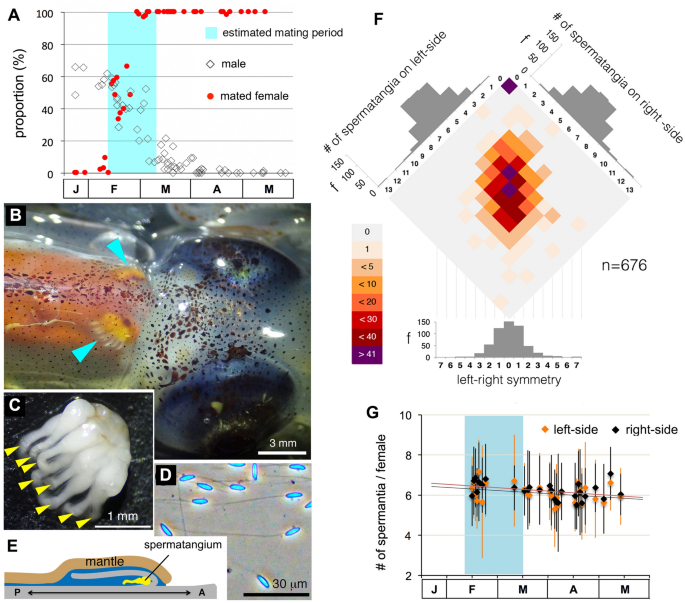
Brockmann, H. J., Colson, T. & Potts, W. Sperm competition inhorseshoe crabs. Behav. Ecol. Sociobiol. 35, 153–160 (1994).
Jones, A. G. & Avise, J. C. Microsatellite analysis of maternity and the mating system in the Gulf pipefish Syngnathus scovelli, a species with male pregnancy and sex-role reversal. Mol. Ecol. 6, 203–213 (1997).
Griffith, S. C., Owens, I. P. & Thuman, K. A. Extra pair paternity in birds: a review of interspecific variation and adaptive function. Mol. Ecol. 11, 2195–2212 (2002).
Birkhead, T. R. & Pizzari, T. Postcopulatory sexual selection. Nat. Rev. Genet. 3, 262–273 (2002).
Parker, G. A. & Birkhead, T. R. Polyandry: the history of a revolution. Philos. Trans. R. Soc. Lond. B Biol. Sci. 368, 20120335 (2013).
Fisher, D. O., Double, M. C., Blomberg, S. P., Jennions, M. D. & Cockburn, A. Post-mating sexual selection increases lifetime fitness of polyandrous females in the wild. Nature 444, 89–92 (2006).
Boulton, R. A. & Shuker, D. M. The costs and benefits of multiple mating in a mostly monandrous wasp. Evolution 69, 939–949 (2015).
Magnhagen, C. Predation risk as a cost of reproduction. Trends. Ecol. Evol. 6, 183–186 (1991).
Shuker, D. M. & Day, T. H. The repeatability of a sexual conflict over mating. Anim. Behav. 61, 755–762 (2001).
Roberts, K. E., Evison, S. E., Baer, B. & Hughes, W. O. The cost of promiscuity: sexual transmission of Nosema microsporidian parasites in polyandrous honey bees. Sci. Rep. 5, 10982 (2015).
Laubu, C., Dechaume-Moncharmont, F. X., Motreuil, S. & Schweitzer, C. Mismatched partners that achieve postpairing behavioral similarity improve their reproductive success. Sci. Adv. 2, e1501013 (2016).
Snekser, J. L. & Itzkowitz, M. Serial monogamy benefits both sexes in the biparental convict cichlid. PeerJ 7, e6535 (2019).
Komdeur, J. Mate guarding in the Seychelles warbler is energetically costly and adjusted to paternity risk. Proc. Biol. Sci. 268, 2103–2111 (2001).
Hosken, D. J., Stockley, P., Tregenza, T. & Wedell, N. Monogamy and the battle of the sexes. Annu. Rev. Entomol. 54, 361–378 (2009).
Emlen, S. T. & Oring, L. W. Ecology, sexual selection, and the evolution of mating systems. Science 197, 215–223 (1977).
Wittenberger, J. F. & Tilson, R. L. The evolution of monogamy: hypotheses and evidence. Annu. Rev. Ecol. Syst. 11, 197–232 (1980).
Young, R. L. et al. Conserved transcriptomic profiles underpin monogamy across vertebrates. Proc. Natl. Acad. Sci. USA 116, 1331–1336 (2019).
Whiteman, E. A. & Cote, I. M. Monogamy in marine fishes. Biol. Rev. Camb. Philos. Soc. 79, 351–375 (2004).
Kaiser, S. A., Risk, B. B., Sillett, T. S. & Webster, M. S. Ecological and social factors constrain spatial and temporal opportunities for mating in a migratory songbird. Am. Nat. 189, 283–296 (2017).
Komers, P. E. & Brotherton, P. N. Female space use is the best predictor of monogamy in mammals. Proc. Biol. Sci. 264, 1261–1270 (1997).
Kvarnemo, C. Why do some animals mate with one partner rather than many? A review of causes and consequences of monogamy. Biol. Rev. Camb. Philos. Soc. 93, 1795–1812 (2018).
Iwata, Y. et al. Why small males have big sperm: dimorphic squid sperm linked to alternative mating behaviours. BMC Evol. Biol. 11, 236 (2011).
Squires, Z. E., Wong, B. B., Norman, M. D. & Stuart-Fox, D. Multiple fitness benefits of polyandry in a cephalopod. PLoS ONE 7, e37074 (2012).
Marian, J. et al. Male alternative reproductive tactics and associated evolution of anatomical characteristics in loliginid squid. Front. Physiol. 10, 1281 (2019).
Morse, P. & Huffard, C. L. Tactical tentacles: new insights on the processes of sexual selection among the cephalopoda. Front. Physiol. 10, 1035 (2019).
Hanlon, R. T., Smale, M. J. & Sauer, W. H. H. The mating system of the squid Loligo vulgaris reynaudii (Cephalopoda, Mollusca) off South Africa: fighting, guarding, sneaking, mating and egg laying behavior. Bull. Mar. Sci. 71, 331–345 (2002).
Hirohashi, N. et al. Sperm from sneaker male squids exhibit chemotactic swarming to CO2. Curr. Biol. 23, 775–781 (2013).
Hirohashi, N., Tamura-Nakano, M., Nakaya, F., Iida, T. & Iwata, Y. Sneaker male squid produce long-lived spermatozoa by modulating their energy metabolism. J. Biol. Chem. 291, 19324–19334 (2016).
Apostolico, L. H. & Marian, J. Dimorphic ejaculates and sperm release strategies associated with alternative mating behaviors in the squid. J. Morphol. 278, 1490–1505 (2017).
Hoving, H. T., Fernández-Álvarez, F. Á, Portner, E. J., Portner, E. J. & Gilly, W. G. Same-sex sexual behaviour in an oceanic ommastrephid squid, Dosidicus gigas (Humboldt squid). Mar. Biol. 166, 33 (2019).
Hanlon, R. T., Ament, S. A. & Gabr, H. Behavioural aspects of sperm competition in cuttlefish, Sepia officinalis (Sepioidea: Cephalopoda). Mar. Biol. 134, 719–728 (1999).
Franklin, A. M., Squires, Z. E. & Stuart-Fox, D. The energetic cost of mating in a promiscuous cephalopod. Biol. Lett. 8, 754–756 (2012).
Hoving, H. J., Bush, S. L. & Robison, B. H. A shot in the dark: same-sex sexual behaviour in a deep-sea squid. Biol. Lett. 8, 287–290 (2012).
Hanlon, R. T. & Messenger, J. B. Cephalopod Behaviour 2nd edn. (Cambridge University Press, Cambridge, 2018).
Nigmatullin, C. M., Arkhipkin, A. I. & Sabirov, M. S. Age, growth and reproductive biology of diamond-shaped squid Thysanoteuthis rhombus (Oegopsida: Thysanoteuthidae). Mar. Ecol. Prog. Ser. 124, 73–87 (1995).
Lenz, T. L., Hafer, N., Samonte, I. E., Yeates, S. E. & Milinski, M. Cryptic haplotype-specific gamete selection yields offspring with optimal MHC immune genes. Evolution 72, 2478–2490 (2018).
Wada, T., Takegaki, T. & Natsukari, Y. Alternative male mating behaviors dependent on relative body size in captive oval squid Sepioteuthis lessoniana (Cephalopoda, Loliginidae). Zool. Sci. 22, 645–651 (2005).
Mather, J. Mating games squid play: reproductive behaviour and sexual skin displays in Caribbean reef squid Sepioteuthis sepioidea. Mar. freshw. behav. Physiol. 49, 359–373 (2016).
Naud, M. J., Sauer, W. H., McKeown, N. J. & Shaw, P. W. Multiple mating, paternity and complex fertilisation patterns in the Chokka squid Loligo reynaudii. PLoS ONE 11, e0146995 (2016).
Allen, J. J., Akkaynak, D., Schnell, A. K. & Hanlon, R. T. Dramatic fighting by male cuttlefish for a female mate. Am. Nat. 190, 144–151 (2017).
Herring, P. J. Species abundance, sexual encounter and bioluminescent signalling in the deep sea. Philos. Trans. R. Soc. Lond. B Biol. Sci. 355, 1273–1276 (2000).
Hoving, H. J. T., Lipiński, M. R. & Dam, L. The male reproductive strategy of a deep-sea squid: sperm allocation, continuous production, and long-term storage of spermatophores in Histioteuthis miranda. ICES J. Mar. Sci. 67, 1478–1486 (2010).
Cuccu, D. et al. Male reproductive system and spermatophores production and storage in Histioteuthis bonnellii (Cephalopoda: Histioteuthidae): a look into deep-sea squids’ reproductive strategy. Deep Sea Res. Part I 91, 86–93 (2014).
Lutz, R. A. & Voight, J. R. Close encounter in the deep. Nature 371, 563–563 (1994).
Hayashi, S. Fishery biological studies of firefly squid, Watasenia scintillans, (Berry) in Toyama Bay. Bull. Toyama Pref. Fish. Res. Inst. 7, 1–128 (1995).
Arkhipkin, A. I. et al. World squid fisheries. Rev. Fish. Sci. Aqua. 23, 92–252 (2015).
Hayashi, S. Spawning behavior and embryonic development of the firefly squid, Watasenia scintillans. Bull. Toyama Pre. Fish. Stn. 1, 1–14 (1989).
Jones, O. R. & Wang, J. COLONY: a program for parentage and sibship inference from multilocus genotype data. Mol. Ecol. Resour. 10, 551–555 (2010).
Sato, N., Yoshida, M. A. & Kasugai, T. Impact of cryptic female choice on insemination success: larger sized and longer copulating male squid ejaculate more, but females influence insemination success by removing spermatangia. Evolution 71, 111–120 (2017).
Yuuki, Y. Spawning and growth of Watasenia scintillans in the southwestern, Japan Sea. Bull. Jpn. Soc. Fish. Oceanogr. 49, 1–6 (1985).
Marian, J. E. A. R. Evolution of spermatophore transfer mechanisms in cephalopods. J. Nat. Hist. 49, 1423–1455 (2015).
Burgess, L. A. A survey of seminal receptacles in the Enoploteuthidae. Smithson. Contrib. Zool. 586, 271–276 (1998).
Hedrick, A. V. & Dill, L. M. Mate choice by female crickets is influenced by predation risk. Anim. Behav. 46, 193–196 (1993).
Fromhage, L., Elgar, M. A. & Schneider, J. M. Faithful without care: the evolution of monogyny. Evolution 59, 1400–1405 (2005).
Gomes, B. V., Guimaraes, D. M., Szczupak, D. & Neves, K. Female dispersion and sex ratios interact in the evolution of mating behavior: a computational model. Sci. Rep. 8, 2467 (2018).
Simmons, L. W. & Garcia-Gonzalez, F. Evolutionary reduction in testes size and competitive fertilization success in response to the experimental removal of sexual selection in dung beetles. Evolution 62, 2580–2591 (2008).
Baker, J., Humphries, S., Ferguson-Gow, H., Meade, A. & Venditti, C. Rapid decreases in relative testes mass among monogamous birds but not in other vertebrates. Ecol. Lett. 23, 283–292 (2020).
Bonduriansky, R., Maklakov, A., Zajitschek, F. & Brooks, R. Sexual selection, sexual conflict and the evolution of ageing and life span. Funct. Ecol. 22, 443–453 (2008).
Reichard, U. H. Monogamy: past and present. In Monogamy: Mating Strategies and Partnerships in Birds, Humans and Other Mammals (eds Reichard, U. H. & Boesch, C.) 3–25 (Cambridge University Press, Cambridge, 2003).
Yamamura, O. & Inada, T. Importance of micronekton as food of demersal fish assemblages. Bull. Mar. Sci. 68, 13–25 (2001).
Rodriguez-Munoz, R., Bretman, A. & Tregenza, T. Guarding males protect females from predation in a wild insect. Curr. Biol. 21, 1716–1719 (2011).
Franklin, A. M., Squires, Z. E. & Stuart-Fox, D. Does predation risk affect mating behavior? An experimental test in dumpling squid (Euprymna tasmanica). PLoS ONE 9, e115027 (2014).
Hou, Z., Luo, C., Roberts, J. D. & Wei, C. Sexual pair-formation in a cicada mediated by acoustic behaviour of females and positive phonotaxis of males. Sci. Rep. 7, 6453 (2017).
Wedell, N. Female receptivity in butterflies and moths. J. Exp. Biol. 208, 3433–3440 (2005).
Guevara-Fiore, P., Skinner, A. & Watt, P. J. Do male guppies distinguish virgin females from recently mated ones?. Anim. Behav. 77, 425–431 (2009).
Ruthera, J., Thal, K., Blaul, B. & Steiner, S. Behavioural switch in the sex pheromone response of Nasonia vitripennis females is linked to receptivity signalling. Anim. Behav. 80, 1035–1040 (2010).
Kubodera, T., Koyama, Y. & Mori, K. Observations of wild hunting behaviour and bioluminescence of a large deep-sea, eight-armed squid Taningia danae. Proc. Biol. Sci. 274, 1029–1034 (2007).
Seidou, M. et al. On the three visual pigments in the retina of the firefly squid Watasenia scintillans. J. Comp. Physiol. A 166, 769–773 (1990).
Lipiński, M. R. & Underhill, L. G. Sexual maturation in squid: quantum or continuum?. S. Afr. J. Mar. Sci. 15, 207–223 (1995).
Iwata, Y., Munehara, H. & Sakurai, Y. Dependence of paternity rates on alternative reproductive behaviors in the squid Loligo bleekeri. Mar. Ecol. Prog. Ser. 298, 219–228 (2005).
Apostólico, L. H. & Marian, J. E. A. R. Dimorphic male squid show differential gonadal and ejaculate expenditure. Hydrobiologia 808, 5–22 (2018).
Thiel, T., Michalek, W., Varshney, R. K. & Graner, A. Exploiting EST databases for the development and characterization of gene-derived SSR-markers in barley (Hordeum vulgare L.). Theor. Appl. Genet. 106, 411–422 (2003).
Untergasser, A. et al. Primer3-new capabilities and interfaces. Nucl. Acids Res. 40, e115 (2012).
Kalinowski, S. T., Taper, M. L. & Marshall, T. C. Revising how the computer program CERVUS accommodates genotyping error increases success in paternity assignment. Mol. Ecol. 16, 1099–1106 (2007).
Sherman, G. B. et al. Impact of candidate sire number and sire relatedness on DNA polymorphism-based measures of exclusion probability and probability of unambiguous parentage. Anim. Genet. 35, 220–226 (2004).
Source: Ecology - nature.com



